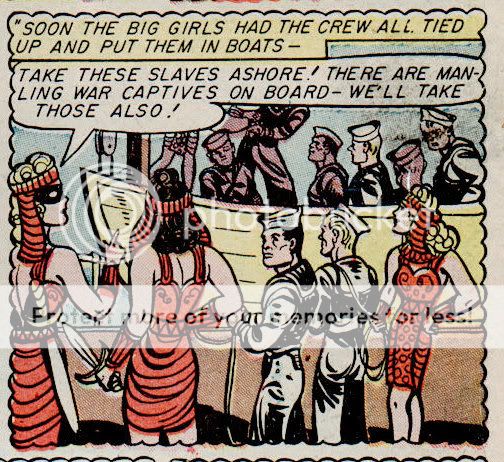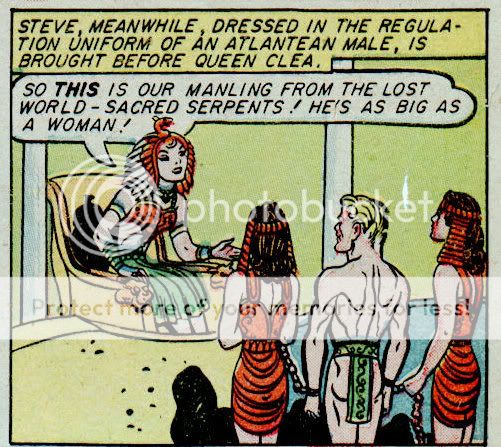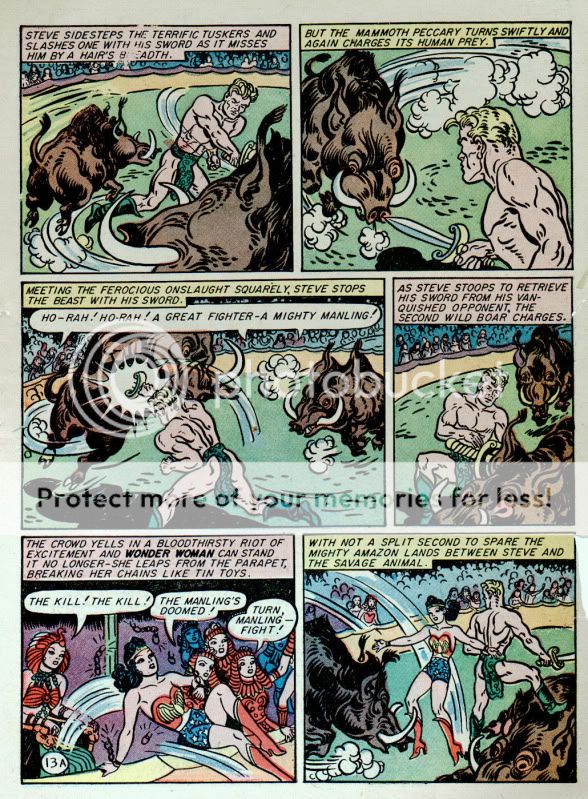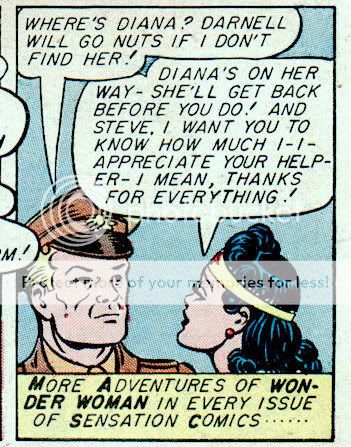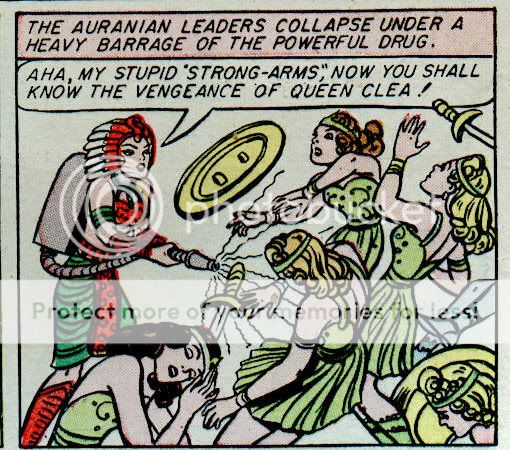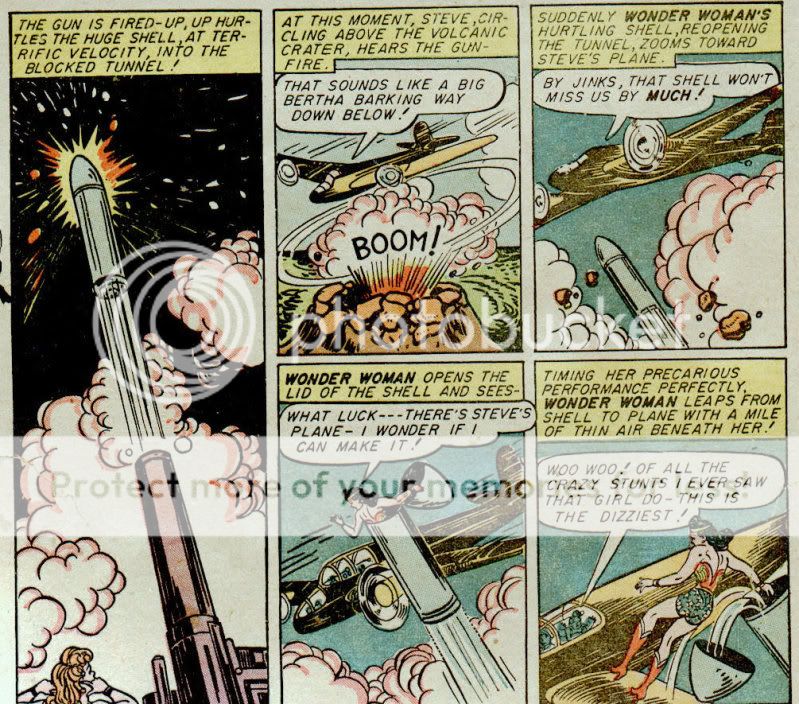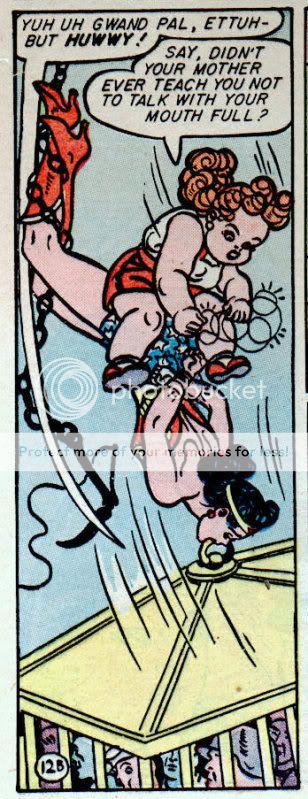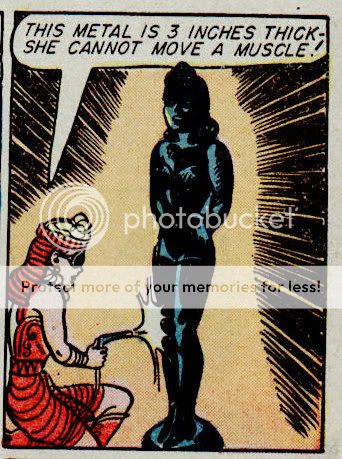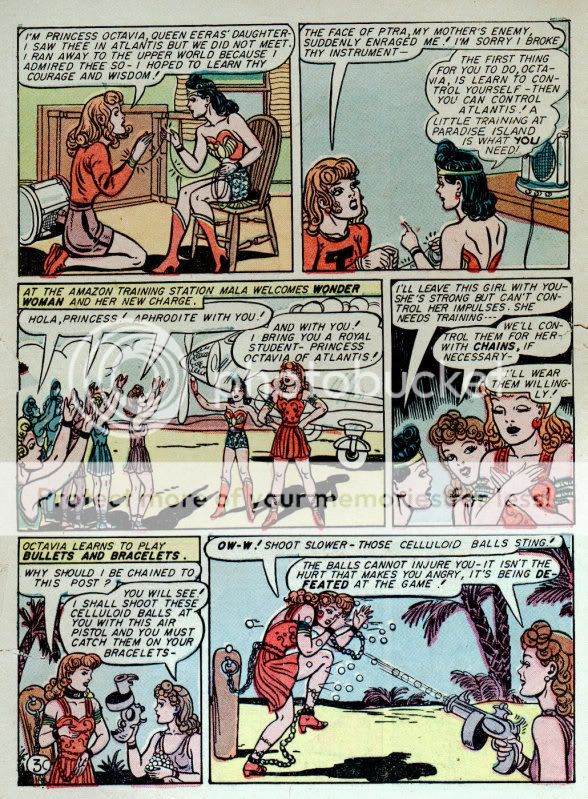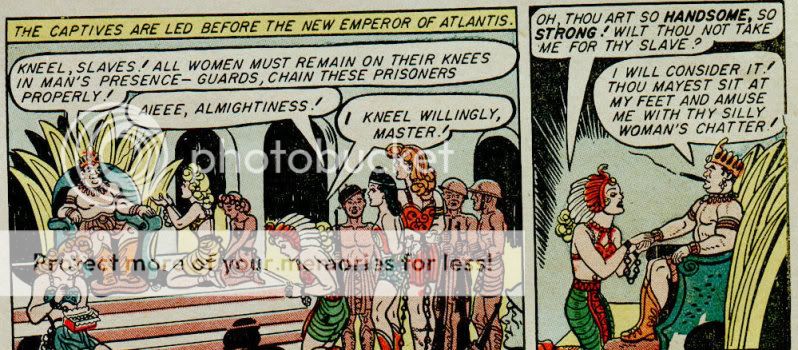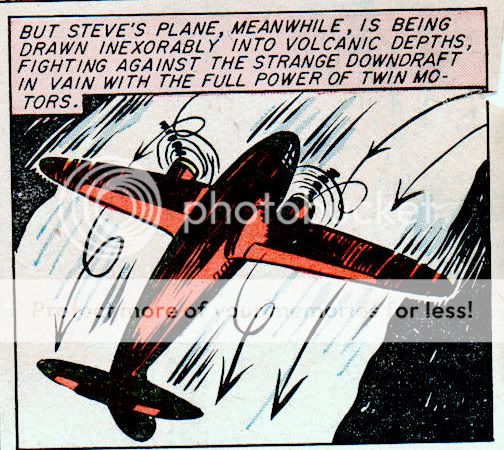Don Heck drew horror comics. Take a look.
Monthly Archives: May 2009
Fun Home
Noah speaks out:
Fun Home more or less defines middle-brow, I think, at least for me. I found it really boring and predictable — earnest anecdote, earnest anecdote, moment of clarity, moment of ambivalent trasncendence, earnest anecdote…I felt like she might as well have just cut and pasted the thing from random scenes from This American Life. Yeah, there were literary references, but every time she dropped one I heard the thud. And her art does nothing for me.
Ouch! This might hurt even worse if I had ever listened to This American Life. Did David Sedaris use to do broadcasts on that show? I really liked Naked, but the book doesn’t remind me much of Fun Home.
Bound to Blog: Wonder Woman #8
Good lord is that cover fantastic. Peter’s animal drawings are always among the absolute best things he does; the wavery lines are so tactile, and the liberties he take with anatomy, halfway between cartooning and those Renaissance prints where it was clear they’d never seen a rhinoceros, or whatever, but damned if they weren’t going to draw the best of whatever bizarre rhinoceros-like thing had gotten lodged in their heads…I don’t know, it’s late and I’m babbling, but the misshapen ears on that boar, and the look of confusion in its little pig eye, and the way its hooves just sort of stick out stiffly, like it doesn’t know what to do with them… Dayenu, as my people say. But the rest of the drawing is fabulous too; I love the way the motion lines are a compositional device, drawing the attention just off dead center. and WW’s position is really lovely; it’s stiff and weird, like all Peter’s drawings, but there’s also a sense of actual movement. And the back muscles on the gladiator ; they’re not right, but the lines are so mobile that they seem righter than right…and the pattern on that kilt. I love Peter’s red swirly things, these perfect art nouveau patterns dropped into his insane outsider-art compositions.
Also, I like that Peter has chosen to draw this so it looks like Wonder Woman is assaulting some anonymous gladiator with a giant pig. I think (from the interior) that that is actually Steve Trevor, and she’s saving him…but you sure wouldn’t know that to look at it.
Anyway, the plot: it has something to do with the lost continent of Atlantis, which is, improbably, underground. It’s ruled by extraordinarily large and powerful women, which gives Peter a chance to have a lot of fun with scale:
Tiny little baby sailor men. Cute!
Not surprisingly , exact relative sizes are awfully unclear, but in theory the Atlantean men (or “manlings”) are supposed to be unusually small and weak. It’s like that episode of Star Trek the Next Generation, where the crew lands on a planet with powerful women who oppress their male compatriots, and we all learn that sexism is bad because, after all, guys, you wouldn’t like it if it were done to you, right? Except, of course, Marston does like it when it’s done to him. You can almost hear him chuckling maniacally in the background. Helpless sailors! That’s hot! hot! hot!
I talked a little in the discussion of Wonder Woman #7 about how Steve is really played as a himbo; a dumb, hunky slab of cheesecake for the young female reader. There’s certainly more evidence for that here, as you see in the panel below, where Clea, the evil ruler of Atlantis, has Steve brought before her in an interesting ceremonial outfit:
“…sacred serpents! He’s as big as a woman!” indeed. What exactly is she seeing under that loin-cloth that made her start prattling about snakes, I wonder?
Of course, a woman wouldn’t actually have a bigger snake than Steve…except, in Marston, she really might. Marston isn’t just interested in straightforward role reversal, as the Star Trek episode was. He’s interested in something a bit more…queer. With that fabulous headdress and the outfit out of burlesque, Clea might as well be in drag, and Steve’s outfit…well, say no more. As I’ve mentioned before, WW is in some sense Marston’s ideal self; he wants to be a goddess. Part of being female, naturally enough, would be desiring men. In this scene, I think Marston both desires and desires to be both Clea and Steve. The excitement is in the slippage from identity to identity and desire to desire; in the severing and subsequent circulation or diffusion of the phallus. In masochism, the appeal is that you escape the law and your identity in relation to the law in order to become someone and something else — including the phallus itself. That’s what fetishizing the female body is; it’s turning a woman’s body into the phallus — the source of authority and power. So when Clea says “He’s as big as a woman!” she’s actually comparing his phallus to *the* phallus; she is, in other words, fetishizing him right back.
I’ve talked about the agonized, repressed gay content in Cerebus before (to speak of another swords and sandalsish example.) The investment here seems very different though…basically, because, while I guess it might be considered repressed in some sense, it’s just not especially agonized. For Cerebus, holding onto male identity involves a rather desperate rejection of femininity…a rejection which, in turn, carries connotations of homosexuality (if you don’t like women, what do you like?) This quandary has no power over Marston. It’s true that the Steve-Clea relationship and/or the Steve-Marston relationship can be seen as queer…but Marston doesn’t shy away or run scurrying from the implications. He embraces them:
That’s flirting behavior, that is. And sure, he’s punished for it and sentenced to die because he’s just too, too flamboyantly strong. But that’s an excuse, not for torment and agony, but for a expulsive release of testosterone and romping with boars. And, of course before Steve can be crushed by a “mammoth peccary”, as Marston puts it, he’s quickly rescued from phallic immolation by the arrival of Marston-in-drag, aka Wonder Woman.
This sort of thing makes it awfully hard to take seriously Marston’s half-hearted gestures at traditional romance comics tropes…are we really supposed to believe WW and Steve are shy with each other after they’ve rolled around in their underwear with pigs?
Anyway, I also like this scene, where Clea wanders around with a suggestive hose spraying her unsuspecting adversaries as they swoon ecstatically.
Or this one, where WW has concealed herself in a intriguingly shaped projectile:
And then there’s Etta, who’s butchness and artificiality — Parker makes her more and more distorted and dwarfish as the series goes along — could, I think, also be read as a kind of transvestite drag. Certainly, she’s carrying around a big-enough phallic substitute here:
And then there are moments like the below.
WW has frequently been read (starting with Frederic Wertham) as a lesbian fantasy, whether for women or men. The fact that it could almost as easily be read as gay fantasy (again for men or (shades of yaoi) for women) has gotten a lot less attention. The point, though, is less that it’s gay, or straight, or lesbian, or all three, than it is the sloughing off of stable identity in the interest of deliriously clunky role-playing. Thus, in the above image, Marston surely gets off on the idea of two women together, but he’s also as surely identifying with both of them; he’s viewer and role-player, excited by both the lesbian connotations and by the sublimated male impersonation. As Linda Williams writes in Hard Core, her classic study of pornography, sexual identity in masochistic scenarios is “an oscillation between male and female subject positions held simultaneously, in a play of bisexuality, at the level of both object choice and identification.”
The obsession with identity play is also indicated by Marston’s obsession with masks and concealment:
That last one doesn’t include a mask, of course, but it is a case of dual identities and role-playing. Wonder Woman is in her Diana Prince disguise; meanwhile the Atlantean Princess she’s talking to is disguised (not super-effectively, I’ll grant you) as a college football enthusiast. Moreover, the disguises are, I think, meant to be sexy or exciting in large part because of gender ambiguity. Both costumes are butch; Diana in her severe military uniform and the Atalantean in her football outfit. And not satisfied with that, Marston has to hand her the biggest phallic cliche in the book:
Yep, she’s smoking a cigar there. This scene could be lifted, almost as is, and put in a cross-dressing screen comedy of the day, where the joke would be that the agressive, giant, cigar-smoking woman and her uncomfortable, nerdy companion are actually both men. Or it could be dropped into a women in prison movie, and the butchness would connote lesbianism. For Marston it’s both, more or less; the shivers of pleasure come from imagining himself as the powerful, phallus wielding woman and imagining himself dominated by her as the nerdy Diana is…or dominating her, as WW inevitably does:
Of course, we all know that Marston loves, loves, loves everyone to submit to loving authority. But he also loves role-playing, which means he loves drama…and you don’t get a whole lot of drama if everyone is submitting lovingly. Like most masochists, Marston may say he wants to be dominated, but he also wants to rebel — so there can be more domination and more rebellion and etc. etc. It’s not enough for Marston to have the weakling manlings of Atlantis be subjugated; he has to have them rebel and dominate their captors so they can be tied up again too.
It’s interesting in this context how theatrical Peter’s art is; everything looks like it could be taking place on stage. He almost always shows the action form the mid-distance, so entire bodies are visible; close-ups are few and far between. The costumes and backgrounds look more like dress-up and stage sets than like real life. The king with the crown and the cigar really looks like a diminutive gangster playing dress up on a throne too big for him. And the stiffness of Peter’s figures generally suggests tableaux; the scenes look frozen and staged even at their most action adventurey:
The paracutes in that second panel come out of the volcano like jack-in-the-boxes; the motion lines don’t so much rush them from the opening as anchor them to it. And that last panel; the center parachuting pirate almost seems to be posing for the camera . The men in the foreground act as a kind of cinema audience — their hands are even raised as if they’re about to clap.
As long as I’ve worked my way back around to Peter’s art maybe I’ll finish with these:
I love those arrows tieing themselves in knots around the plane, and that adorable, tiny, misshapen whale on the map. I just ordered the Les Daniels WW book, and I’m hoping it’ll maybe tell me a little more about Peter’s background and his relationship with Marston. You can’t help but wonder what he thought about all this stuff; he certainly embraced the fetish aspects enthusiastically enough. But then, maybe he would have been just as happy drawing miniature cetaceans….
Monobrow
in a post about reissues and Yoshihiro Tatsumi Bill politely accused me of wanting to fetishize comics as trash. I volleyed back that, hey, I like Fort Thunder, and then I added this:
I have more problems with middle-brow…stuff that makes a pretense of being important but doesn’t actually have anything to say, and doesn’t make any effort to say it in an original way.that’s kind of problematical definition of highbrow vs. middlebrow, essentially calling highbrow what you like & middlebrow what you don’t like.
Bill seemed satisfied, but then Miriam called me out on the carpet:
that’s kind of problematical definition of highbrow vs. middlebrow, essentially calling highbrow what you like & middlebrow what you don’t like.
i’m sure adrian tomine would say he has something to say & makes an effort to say it in an original way (in “sleepwalk,” none of the stories has an ending, until the last one! that’s a unique approach in comics, albeit a stupid one).
“fun home” engages with ulysses, etc., & as i recall you didn’t like it. does that make it middlebrow because it failed, by your definition?
also, the earlier schrag high school chronicles weren’t terribly literary (in the sense of explicitly engaging with the literary canon). would you define them as highbrow, & if so, why?
So, okay, I will try to defend myself, more or less.
I haven’t read anything by Adrian Tomine, honestly, and I’ve barely looked at his art. To the extent I’ve seen anything by him, it didn’t make me want to look at anything else, but I can’t classify him as highbrow or lowbrow or even cueball bald without reading more (or anything) that he’s written.
Fun Home more or less defines middle-brow, I think, at least for me. I found it really boring and predictable — earnest anecdote, earnest anecdote, moment of clarity, moment of ambivalent trasncendence, earnest anecdote…I felt like she might as well have just cut and pasted the thing from random scenes from This American Life. Yeah, there were literary references, but every time she dropped one I heard the thud. And her art does nothing for me.
Schrag’s first book, Awkward, I think probably actually qualifies as low-brow in some sense; it’s a high-school journal in a lot of ways. She kind of keeps that all the way through too; in Likewise she sort of reinterprets Ulysses as a girlie journal. The way she maneuvers around high-art, low-art distinctions is one of the things I like about her, actually. I think it’s also part of the reason she doesn’t receive as much critical enthusiasm as she should — folks don’t quite know what to make of her.
As for Miriam’s broader point — she’s certainly right that I’m pretty much using middle-brow to mean “things that are pretentious but stupid” as opposed to things that are pretentious but manage to deliver (high-brow) and things that don’t have a ton of pretensions (low-brow.) There are a lot of problems with that definition obviously — for one thing, low-brow work often has pretentions to its lowbrowness — that’s the case, for example, with a lot of country music. And drawing a line between high-brow and middle-brow can be tricky. I guess one way to think about it is relationship to the avant garde, or to high-art modes. Fort Thunder is thinking about visual gallery art, which is definitely high-brow; Fun Home is thinking about memoir, which I think is middle-brow.
Just being high-brow doesn’t mean it’s good, of course…there’s lots of bad visual art, and it’s all still high-brow, not middle-brow. I think free jazz is generally pretty boring, but it’s boring high-art, not boring middle-brow art. The question, though, is whether I can think of any middle-brow art I think is good. I was going to float Marston’s Wonder Woman, but on second thought that’s really pretty clearly low-brow… I like Simon and Garfunkel, who I think are pretty solidly middle-brow; they have pretensions, they’re not necessarily all that smart, but it’s redeemed by formal elements like the songwriting and the harmonies (and I do find their twee lameness kind of appealing, I have to admit.) I like Joni Mitchell. I”m not doing well with the comics though…I think Y:The Last Man would qualify — it’s got major pretensions wrapped in a very accessible genre package. And I sort of liked it…though not enough to really say it breaks the mold. I don’t know…anyone want to float a better segmentation of high/middle/low brow than I’ve managed to come up with? Or tell me something that’s middle-brow that I should like?
High Point of the Day
It was beautiful weather this evening and I was up on Mt. Royal for my constitutional. The centerpiece of my walk is always a few trudges up and down the long, long set of stairs that leads from one of the mountain’s scenic walkways to the mountain’s top. On a sunny day the stairs typically feature a population of tourists and exercise freaks, and today there was also a young couple closely joined at the hip while they were being photographed. I should point out that the great staircase, made of a charming rustic wood, has landings and, like everything else, the landings are shaded by the green trees that crowd about the scene. If you want to pose for a photograph, some very good spots are available. The couple and their photographer had chosen one such spot. I stood still and watched while the photographer took a picture, then I passed on down the staircase, and then, a couple of minutes later, I passed back up.
“Is this professional?” I asked, meaning the shoot. The photographer was as young as the couple, and the three of them were joking back and forth, so they might have been friends just having fun. But he told me, yes, it was a professional shoot. “Do you want to be an extra?” he asked, bringing me into the moment. I said sure, I’d stand in the background and hold a stick. Everyone was in such a good mood that this was considered funny too.
As I passed the couple, I asked if they were getting married. The girl said yes, and I told them congratulations. They were quite a handsome pair: two well-knit mesomorphs with regular bone structure and pleasant expressions.
“Aren’t they nice looking?” the photographer called after me.
“You bet,” I said. “They’re great looking.” Then, to the couple: “Go have some good-looking kids!”
The girl, lively and cheerful: “That’s the plan!” Along with sounding lively and cheerful, she also sounded a bit shy, like someone who doesn’t normally toss out gay quips for the general company. The boy’s smile, as I met his eyes, was a little abashed, and one got the feeling that he did not expect random passersby to be appraising his looks. I guess what I mean to say is that, to be frank, a lot of good-looking people are kind of a pain and that these kids struck me as not being pains.
And that was it, that was the high point of my day. It was a real nice three minutes.
Golden Age Gallery: Eisner Monday

President Obama Enters HU Debate
We’ve been hassling about faith and nonbelief here and here at the HU (and special thanks to commenter John Hennings for his Christian point of view on the matter). President Obama’s address at Notre Dame yesterday is being excerpted on the liberal blogs (here’s James Fallows), so of course I’ve stumbled across it. What appears to be a key passage:
… the ultimate irony of faith is that it necessarily admits doubt. It is the belief in things not seen. It is beyond our capacity as human beings to know with certainty what God has planned for us or what He asks of us, and those of us who believe must trust that His wisdom is greater than our own.
I’m a Christian. I entered this fascinating discussion late. I’d like to take it back to the quoted text (Matthew 6:5-6). The common interpretation of this scripture by those who read it in context is that Jesus is forbidding praying for the purpose of looking pious to others, not necessarily all public prayer. The quote is from the Sermon on the Mount, Jesus’ longest continuous monologue in the Gospels. Among other things, the Sermon on the Mount repeatedly calls people to exercise a purer morality, one that comes from a righteous attitude of the heart. In other words, intent matters as much as action. This was revolutionary in an age and a place where the Pharisees, the leading religious sect, were advocating strict compliance to an externally visible, rules-based religion, and using social opprobrium to enforce it. A tendency toward Pharisaical legalism and its accompanying hypocrisy is endemic to humanity and probably all religion. We want to reduce God to a genie in a lamp. If we follow the rules, we get what we want. The God Jesus is talking about wants a real relationship, and He (for lack of a gender-neutral personal pronoun) wants to help us become better than what we are. It’s the difference between an ATM machine and a parent, or between a prostitute and a loving spouse. Correcting this fundamental mistake and enabling real connection with a loving divine creator were what Jesus’s life, death, and resurrection were all about. It’s also why He got so enraged about hypocrisy.
I think communal prayer can be an effective and even instructive part of worship, and it is hugely beneficial to spiritual intimacy and fellowship in smaller groups, as when “two or three are gathered together.” However, trying to please people instead of God is a constant danger in prayer and almost every other aspect of worship or life in general. Consequently, it’s one many of us talk about a lot, like teachers harping on drugs in schools.
Apparent contradictions in the Bible can often be resolved by looking at the text in context — often the immediate context, but sometimes scripture as a whole. That said, Noah makes an excellent point that as in science, there are some things even the most knowledgeable people of faith (e.g., Ravi Zacharias or Norm Geisler) don’t fully understand and can’t adequately explain. I like Noah’s comparison to the mystery of gravity; one of my other favorites is the dual wave/particle nature of light, since it reminds me of the Trinity — a mystery so puzzling that Christians came up with a name for it. It sounds much more impressive to say “Oh, that’s the Trinity,” than to say “We really can’t explain why Jesus talks about God the Father and the Holy Spirit in third person sometimes and first person others, why He claims to be God, and yet He talks to God, and doesn’t contradict Jewish monotheism, etc. It’s a real puzzler.”
Part 2!
First, thanks for the kind words. After all that about pleasing God and not people, it’s ironic that I‘m happy to have pleased you, but I respect your opinions, so I guess it makes sense.
Now on to Tom’s questions.
My argument (with some borrowed bits) that Christ wasn’t forbidding all public prayer goes like this: First, it’s consistent with the rest of the chapter, starting with verse 1: “Be careful not to practice your righteousness in front of people, to be seen by them. Otherwise, you will have no reward from your Father in heaven.” Second, He himself prayed in front of others in Matthew 11, Matthew 27, and Luke 9, although the first two were VERY brief, and in the other, we don’t know what was said. He also strongly implied that group prayer was okay in Matthew 18, verses 19 and 20: “Again, I assure you: If two of you on earth agree about any matter that you pray for, it will be done for you by My Father in heaven. For where two or three are gathered together in My name, I am there among them.” I know one of these was already referenced, but I think the two verses quoted together strengthen the case. Side note: I am walking right past the theological questions this passage raises, like to whom those verses apply and what it means to be gathered “in His name” – at least for now. I have to go to work eventually.
Finally, the Acts of the Apostles (also written by physician/historian Luke) describe the Apostles and other early Christians as praying both privately and communally. There are recorded instances of the Apostles and early believers holding each other accountable on points of doctrine. Consequently, one would not expect this to go without dispute if at least some of them understood Jesus as totally forbidding prayer in front of others. Paul even called Peter on the carpet once. It wasn’t related to prayer, but it was about trying to please people instead of God (Galatians 2).
Finally, in the interest of full disclosure, I should point out that the Gospels portray Jesus as habitually slipping off and praying in private. So He practiced what he preached, to the point frustrating the Apostles and others attempting to track Him down.
… the annual National Day of Prayer and national days of prayer in general are intended to promote prayer, especially prayer for the nation. Congress and occasionally the President have been proclaiming them since 1775, although not unanimously. They’re based on the idea that prayer makes a difference in the real world, and until they were made annual, mostly associated with times the U.S. was in a jam. They’ve always been ecumenical and therefore respecting no particular established religion. Also, they’re resolutions, not laws that people have to follow, so most have not had Constitutional issues with them. Being seen as a supporter of prayer was probably also the right answer politically for most of our history. The history of national days of prayer and their more recent promotion by the evangelical community can be viewed on these sites (http://www.
religioustolerance.org/day_ , andhttp://www.ndptf.org/about/pray2.htm index.cfm ). The problem with all this, obviously, is that it’s difficult to promote prayer without coming across as self-righteous and Pharisaical, or maybe even becoming so (just a little bit?). Jesus managed to do it by living as unpretentious, sincere and unselfish a life as one could live (which must have made the occasional claims of deity simultaneously jarring and more credible). If we had more credibility, as we once did, this would be more accepted. It still is accepted on a peersoanl level from Christians with whom people have personal experience and a relationship of trust.





